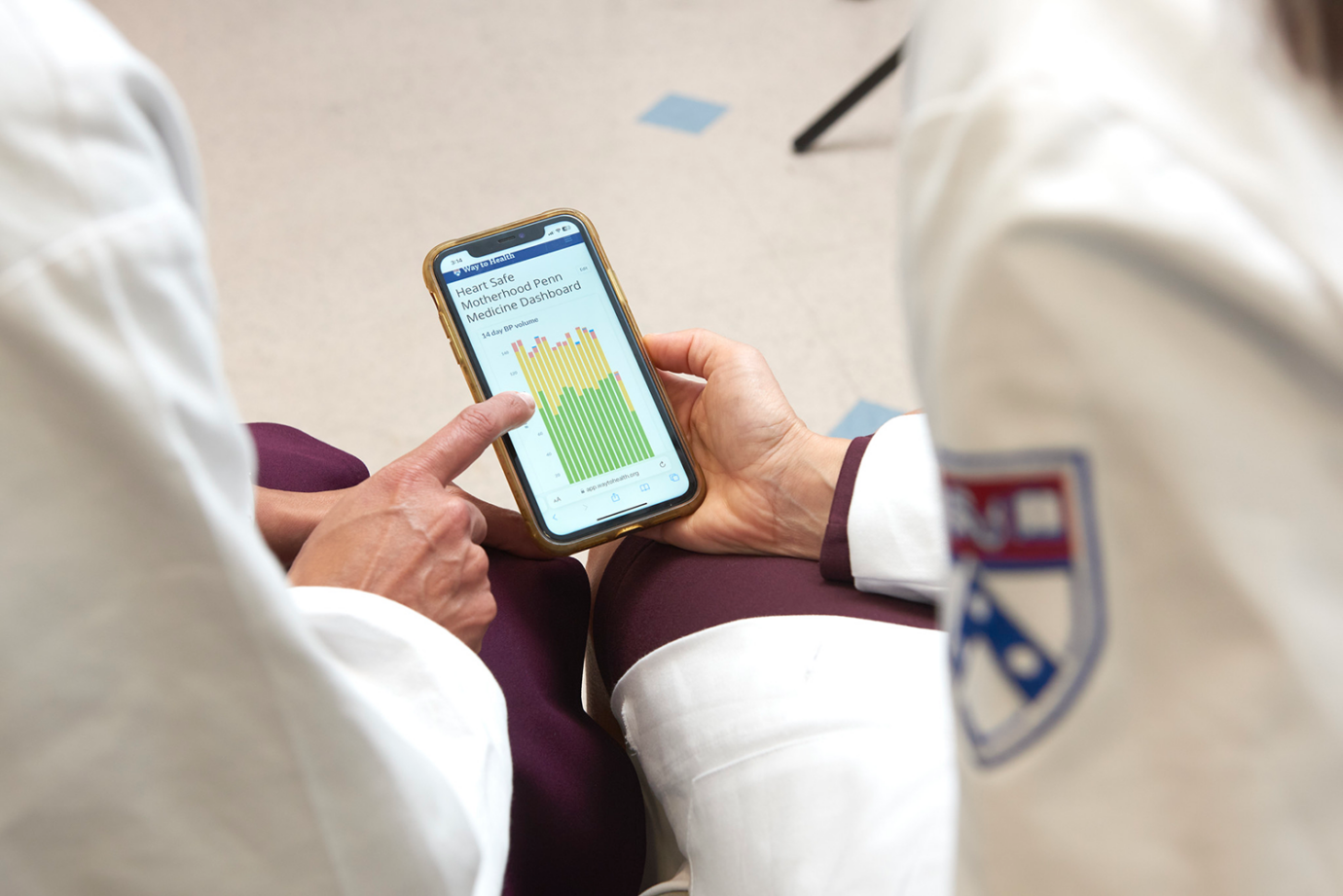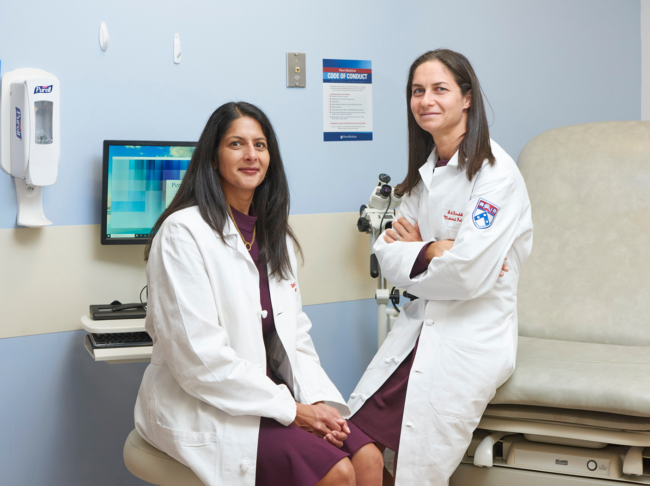

New mothers and their babies typically leave the cocoon-like environment of the hospital maternity floor within a few days of delivery. Their discharge marks the end of a particularly intense nine months of medical support: from the monthly, then biweekly, then weekly obstetric exams during pregnancy to the 24/7 access to nurses in the hospital. Once they return home after giving birth, most new parents will not be seen by a medical professional for the next month and a half, until the typical six-week postpartum appointment with their obstetrician.
But for the unlucky few, early postpartum problems can quickly develop into much more serious complications. Of the approximately 1,000 childbirth-related deaths in the United States each year, about one in every five occurs between one week and six weeks postpartum. “It’s not a complicated delivery or somebody who is very sick,” said Mario DeMarco, MD, an associate professor of Clinical Family Medicine and Community Health in the Perelman School of Medicine at the University of Pennsylvania and director of Family Medicine Obstetrics. “It’s someone who gets discharged from the hospital and experiences some sort of symptom. It could be cardiomyopathy or preeclampsia or stroke. It could be suicide, homicide or a drug overdose. For them, a six-week visit wouldn’t have been helpful.”
For this reason, addressing risks in those first few weeks postpartum is a key part of Penn Medicine’s comprehensive, system-wide effort to reduce maternal morbidity and mortality, and in particular to eliminate inequities in which Black patients and other racial and ethnic minorities disproportionately experience poor outcomes. Some of the core principles underlying the efforts include standardizing patient care during key moments in pregnancy and childbirth to reduce opportunities for racial bias, centering equity as a goal, and wielding influence across the city and nation to extend the innovations proven at Penn Medicine to help new families in more places.
The First Six Weeks Postpartum
In the first six weeks before a new parent’s typical first postpartum checkup, the elation of new motherhood is often mixed with a great deal of stress. New mothers are still recovering from childbirth, dealing with pain and soreness, heavy vaginal bleeding and urinary incontinence. Those who had C-sections are bracing their incision site with a pillow during every laugh or sneeze to prevent the stitches from reopening. As many new mothers struggle with breastfeeding, their newborns wail for milk every two to three hours. Faced with what can feel like an endless day of round-the-clock feedings and diaper changes, punctuated by precious little sleep, a whopping 80 percent of new parents report experiencing “baby blues” during the first few weeks postpartum.

“If you talk to moms, you’ll hear there are a lot of symptoms in the two-to-three weeks [postpartum] that they assume is the price they paid for having a child,” DeMarco said. Many new parents struggle alone, finding that, by the time of their six-week appointment, the issues have either resolved on their own (as is typical of postpartum bleeding and baby blues) or they’ve given up (as often happens with breastfeeding). That might explain why as many as 40 percent of women nationally never attend a postpartum visit. “We weren’t delivering care in a time-sensitive way,” DeMarco said.
The American College of Obstetrics and Gynecology agreed, and in 2018 recommended that new mothers are seen sooner, specifically within three weeks of giving birth.
As part of a Penn Family Care program focused on “the fourth trimester,” or the first three months post-delivery, these practices set a goal for all patients to have a postpartum visit within three weeks of delivery—either in person or via telehealth—in addition to their baby’s regular checkups. Since implementing the program in 2021, the proportion of Penn Family Care patients with a postpartum visit within the first three weeks more than quadrupled to 64 percent from 15 percent. Though the findings were consistent in Black and non-Black patients, the option of telehealth postpartum care during the COVID-19 pandemic decreased racial disparities in visit attendance.
But, DeMarco said, while Penn Family Care hopes to lead others to adopt the three-week postpartum visit through their example, the six-week visit remains the typical standard in most health systems. To bridge the gap in these crucial early weeks, Penn Medicine rolled out several initiatives that leverage technology to make it easier for patients to access postpartum care.
Texting Buddies for Triage
Healing at Home is a text messaging program for low-risk postpartum patients who delivered at the Hospital of the University of Pennsylvania. It covers the period from hospital discharge to the six-week postpartum visit, keeping patients engaged in their health through interactions with “Penny,” an AI-augmented conversational agent. Penny sends personalized messages with anticipatory guidance, such as “your baby’s umbilical stump will fall off soon,” and can also answer most patient questions on breastfeeding, constipation and more.
“I see Healing at Home as a triage for which patients need extra support,” said Kirstin Leitner, MD, an assistant professor of Clinical Obstetrics and Gynecology and the Penn Medicine physician who created the program. “It offers [providers] the potential to say, ‘This patient keeps asking questions, or is screening high on her postpartum depression screening or is still having elevated blood pressures. She might be a patient worth bringing in for a [two-week] visit versus a patient who has had her third baby and is smooth sailing.’”

Text messaging is more accessible to people with fewer resources, Leitner said, such as those who don’t have internet at home, since most do have a cell phone plan with unlimited text messaging. Since its launch in March 2020, Healing at Home has had more than 1,800 participants. Of the top 10 percent of highest-engagement users—that is, participants who asked a lot of questions, followed up with Penny and used emojis and pleasantries with the conversational agent—90 percent were Black women. Patients who are breastfeeding their baby and patients having their first baby are more likely to engage in the platform. Not only is engagement higher, but there are some improved outcomes such as high rates of contraceptive acceptance and higher rates of exclusive breastfeeding at one week of life.
“There probably is a group of Black, breastfeeding first-time moms who are more likely to engage with Penny than reach out to their provider through traditional communications,” Leitner said. “They’re using this as a tool to reach out. And sometimes, that’s the first step.”
Penn Medicine’s system-wide commitment to reducing maternal morbidity and mortality for Black women has been important to Healing at Home’s success. “I can’t tell you how many times I’ve written in a paper or proposal on the awful rates of maternal mortality in the U.S. compared to other countries,” Leitner said. “To have leadership emphasize this [problem] has been hugely helpful to allow us to bring solutions to people.”
With a grant from the City of Philadelphia, Leitner is now working on starting a non-English version of the program.
Because of efforts at the Hospital of the University of Pennsylvania to boost hypertension screening during pregnancy, most patients enrolled in Healing at Home already own and use a blood pressure cuff. With hypertension a concern for many postpartum women, even those without a previous diagnosis, Leitner added regular self blood pressure checks to Healing at Home in 2021; this has helped connect patients with additional support and intervene sooner. A patient who screens severely high once or mildly high twice is enrolled in a program that is one of Penn Medicine’s longest-established and widest-reaching success stories in using text messaging technology to save lives: Heart Safe Motherhood.

A Success Story in Preventing Postpartum Complications
Heart Safe Motherhood, a text-based, remote blood pressure monitoring program, was established in 2014 in response to poor attendance rates at a postpartum blood pressure clinic for high-risk new mothers, said Adi Hirshberg, MD, director of obstetrical services at the Hospital of the University of Pennsylvania and an associate professor of Clinical Obstetrics and Gynecology, who co-founded the program with Sindhu Srinivas, MD, MSCE, a professor and vice chair for quality and safety in the department. Black patients reported significant barriers to accessing in-person health care, including transportation, childcare and cost. But they were also the group who needed this postpartum health monitoring the most: Black women are more likely to suffer from preeclampsia, a serious condition in pregnancy and postpartum characterized by high blood pressure.
Heart Safe Motherhood provides patients with a blood pressure cuff and educates them on how to use it. Once discharged from the hospital, postpartum patients receive text-message reminders to conduct twice-daily blood pressure readings at home, for 10 days, and report the readings to their providers via reply message. A 2019 study of the program found that vastly more patients—more than 90 percent overall—submitted blood pressure readings via text, versus the number of patients not in the program who attended the in-person clinic. The effect for Black patients in particular was most dramatic, rising to 93 percent submitting readings via text vs. only 33 percent who were checked in person. (By comparison, among non-Black patients, 70 percent had their blood pressure checked in person.)
Penn Medicine’s system-wide focus on maternal health disparities has positive benefits for all pregnant and postpartum patients, said Elizabeth Howell, MD, MPP, chair of the Department of Obstetrics and Gynecology in the Perelman School of Medicine and the Harrison McCrea Dickson, MD President’s Distinguished Professor, who has spearheaded Penn Medicine’s overall efforts with Srinivas.
“The lessons learned are shared for all of our populations,” Howell said. “Our approach to maternal health, our standards, everything we’re doing is being elevated from this effort. We’re targeting the disparity, but it’s going to improve health for all.”

Heart Safe Motherhood is now available for patients at all five Penn Medicine birthing hospitals—the Hospital of the University of Pennsylvania and Pennsylvania Hospital in Philadelphia, and at Penn’s regional hospitals in Chester County, Lancaster, and Princeton—as well as two of the three other Philadelphia birthing hospitals that are not part of the Penn system. The model has also been adopted at an academic hospital in the Midwest, a health care institution in California and a large birthing hospital in the South. The program is enrolling an average of 72 patients every month. As of November 2023, Heart Safe Motherhood had collected more than 252,000 blood pressure readings from nearly 19,000 Penn Medicine patients.
In 2023, a longitudinal study of more than 1,000 patients, completed in collaboration with Independence Blue Cross, found that patients enrolled in Heart Safe Motherhood had fewer adverse events, including seizure and stroke, postpartum emergency department visits and hospital readmissions than those who weren’t enrolled. These benefits were seen up to six months after delivery. The program also resulted in per-member cost savings for the insurer.
“This program is a great example of how a technology-based program can engage patients and reduce severe maternal morbidity and health inequities in the particularly vulnerable time right after birth when people go home,” said Srinivas.
And while the earliest weeks after returning home with a new baby may be the most vulnerable, the opportunity to help new parents sustain lifelong health does not end there, and Penn Medicine is also connecting with these patients to support their ongoing care in the months and years after their child’s birth.
“We are seizing a unique opportunity to meet the moment at a transformational point in our patients’ lives,” Howell said. “It’s so important. Healthy moms, healthy babies, and families are the foundation of healthy communities.”







